| Cindy Sherman
The Art History Archive - Photography
See also: The History of Photography as a Fine Art
Cindy Sherman (born January 19, 1954 in Glen Ridge, New Jersey) is an American photographer and film director known for her conceptual self-portraits. Sherman currently works in New York. Sherman grew up in Huntington, New York on Long Island. She was educated at Buffalo State College, enrolling in the basic studio courses - drawing, painting and photography. Sherman initially failed the required photography class (due to difficulties with the subject's technical side), and decided to focus on her major of painting. Later, however, Sherman studied with a photography instructor (Barbara Jo Revelle) who inspired her to 'just take pictures'. Sherman decided she found the immediacy of photography more appealing than trying to paint perfect copies of things, and switched majors. Sherman works in series, typically photographing herself in a range of costumes. For example, in her landmark 69 photograph series, the Complete Untitled Film Stills, (1977-1980) Sherman appeared as B-movie, foreign film and film noir style actresses. Sherman's most recent series, dated 2003, features her as clowns. Although Sherman does not consider her work feminist, many of her photo-series, like the 1981 "Centerfolds," call attention to the stereotyping of women in films, television and magazines. In response to cuts to NEA funding and attempts to censor photographers Robert Mapplethorpe and Andres Serrano, in 1989 Sherman produced the Sex series. These photographs featured pieced-together medical dummies in flagrante delicto and sex positions. Like much of Sherman's work, many critics find the series both disturbing and funny. Many art critics consider Sherman to be not only the most successful female photographer of the modern era, but one of the most successful artists of either genders in the late twentieth century with as much influence on younger artists as did Andy Warhol in his era.
Sherman has also worked as a film director; her first film was Office Killer in 1997, starring Jeanne Tripplehorn, Molly Ringwald and Carol Kane. She played a cameo role in John Waters' film, Pecker.
In 2006, Sherman created a series of fashion advertisements for designer Marc Jacobs. The advertisements themselves were photographed by photographer Jurgen Teller and released as a monograph on April the 4th by Rizzoli. Sherman has been referenced by the electroclash artists Chicks on Speed in the track "Spoken by Stephanie from Marseille, Yes I Do" from the 2000 K Records album The Re-Releases of the Un-Releases. The song refers to Sherman through the lyrics, "...got more faces than Cindy Sherman." Sherman was also the topic of the song "Cindy of a Thousand Lives", from Billy Bragg's 1991 album "Don't Try This at Home". She's also the subject of The Shermans' song, "Cindy Sherman". A documentary, "Guest of Cindy Sherman" is currently in the works about the travails of artist/videographer Paul H-O and his relationship with the great artist (to air on the Sundance Channel in 2008). The feature documentary is directed by H-O and Tom Donahue.
Directed by: Cindy Sherman.
Cindy Sherman's screen debut "Office Killer": Dorine, shy, always keeping her head down, is a diligent copy editor on 'Constant Consumer Magazine'. She is the kind of woman everyone in the office relies on, but nobody wants to know.
For Dorine it is a much better idea to approach this accidental death as murder. She takes the corpse to her cellar at home, and treats him like a more patient colleague who never nags or complains. Now that she has a taste for blood and revenge, she becomes a serial killer, 'inviting' all her colleagues to her home office. By the end of the movie, Dorine's cellar looks like a 'live version' of Sherman's recent photographs: compositions of decay and rotting bodies. But where the tone of the photos is deadly serious, here it is a brilliant parody of the horror genre. The open ending leaves no doubt about that: since there are no more staff to work for, Dorine heads for a new job as office managerů As in her photographs, Cindy Sherman creates a whole new world, which slightly resembles the one we know, but which operates on its own, bizarre terms. Office Killer is a highly creative work that defies easy definition: it is art and it is camp, it is both within the genre and a self-conscious comment on it, it is horrifying and it is funny. But like every Cindy Sherman creation, it is like nothing any of us has seen before.
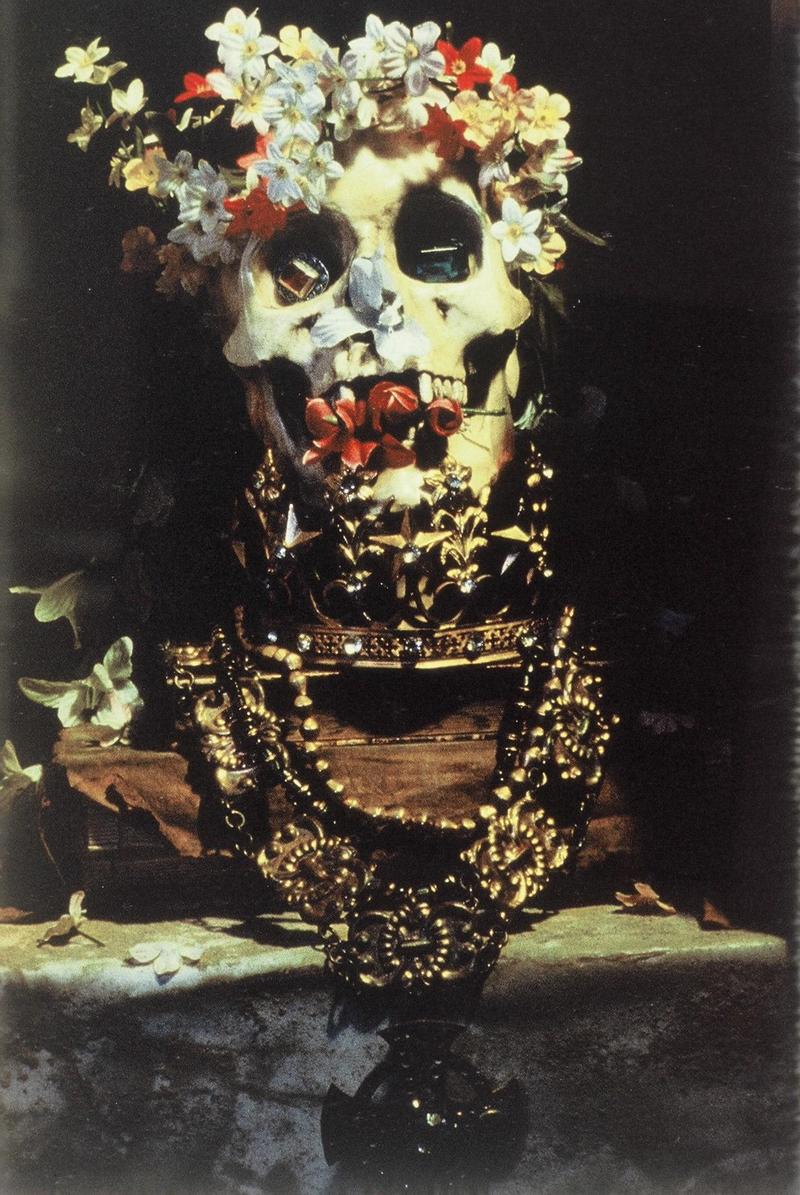
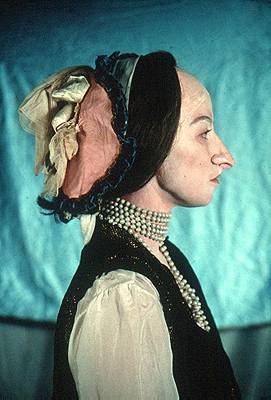
Like Cindy Sherman's artwork? We recommend buying her latest book. |
|
| |
|
Introduction by Peter Schjeldahl and an Afterword by I. Michael Danoff. New York: Pantheon, 1984, 197 pp., $16.95 paper. Review by Elsa Dorfman. NOTE: The book to the right "Cindy Sherman: Retrospective", which is not the same book talked about in this review. We recommend buying both books for those interested in Cindy Sherman. Pantheon has recently published Cindy Sherman, a collection of 39 black-and-white and 50 color photographs. This publication by a relatively young artist (she was born in 1954) is an unusual event: monograph collections of photographs, even by the field's elders, are risky commercial ventures and the books often end up remaindered in a year or two. As Peter Schjeldahl writes in the Introduction, her work is presented "not as 'art photography' but as art, period." Cindy Sherman has cannily succeeded in presenting her work as art not photography, and has avoided the lower sales price and more modest media attention that art photographers are accustomed to receive. As early as 1979, articles about Sherman's work were appearing in Arts Magazine and October. In nearly ten years she has had over 30 one-person shows at prestigious museums and galleries in this country and abroad. Over one hundred articles in publications ranging from Life, the Village Voice, Vogue, Art Forum and the Wall Street Journal to Cahiers du Cinema and Parachute) have focused on her work. I can't think of another person who works with a camera, male or female, young or old, who has received this kind of attention. What is Cindy Sherman's work like? Cindy Sherman photographs herself or has other people photograph her in different scenarios which she concocts and in which she is the sole performer. She puts on wigs, uses elaborate make-up, wears costumes. She transforms herself into a variety of women under 30, the vast majority of whom seem bored and boring, self-absorbed and unhappy. In many of the images Sherman looks like the sullen, artificially glamorous women in advertisements for Vidal Sassoon remoisturing creme and Victoria's Secret lingerie. There is practically no humor in any of the images, no campy, vampy strutting. Sherman is not having fun putting on her wigs, dressing in clothes not her own, and becoming a different person. She isn't Margaret Mead, Madonna, Susan Sontag, a member of the Junior League, or a raving beauty. But it is hard not to respond to the theater of the images and to Sherman's performance or to wonder how she made herself up to look like such different women from image to image. The first 39 images, all on black and white film, were taken between 1977 and 1980. The pictures in their original gallery presentation are 8" by 10"; in the monograph they are reproduced somewhat smaller. Each one is called "Untitled Film Still" and in each one Sherman assumes the persona of a different woman, most often someone out in the world - at a train station, sunning on a deck by the seashore, watering a garden, walking down a city street. Except for one image, "Untitled Film Still #7" (in which Sherman peers from a piano glass while another woman, her face obscured by a large straw hat, crouches in the foreground), they are unpopulated; no one shares Sherman's performance or intrudes on it. My favorites are #56 in which Sherman peers at herself in the mirror, #48 which shows Sherman waiting by the side of the road as if for a ride, valise beside her, #46 which shows her with an underwater swimming mask (one of the few that have the least sense of play); #17 in which she performs as an innocent young woman on a city street, and #21 in which a fearful, suspicious woman is framed by large city buildings. The Untitled Film Stills are set pieces, with the flavor of black-and-white afternoon TV soap operas. They look like what any indiscriminately chosen frame would present if you put your VCR on pause. Each image is unextraordinary and the plainness must be part of Sherman's point, as if to demonstrate that all instants are equal and equally mundane. The performances have a definite artificiality; though all the elements of the images are real, you would not mistake Sherman for a real woman walking down a real street. You know you are looking at some kind of stage set, some kind of contrived situation. The 50 color images are called simply "Untitled." Though they are all reproduced at something less than 8" by 10", in reality they are anywhere from 24" by 48" to a colossal 6 1/2 feet by 4 feet. These images are all in an enclosed unidentifiable space and Sherman has directed the camera so that her performance, not the environment, monopolizes the image. By bringing the camera in close to her, she creates a feeling of nearness, but not of closeness or intimacy. Quite the opposite, most of the women Sherman portrays seem untouchable. In #93, Sherman is hiding as if wounded under brown tousled sheets. In #87, she is lying blankly on a wooden painted floor holding a red and orange blanket. (Shades of red and orange seem to be her favorite hues.) In #85 she is on the floor again, pained expression again, possibly trying to figure out if she can gather strength to get up. In #103, she is standing, hurt and seductive. In #99, she is clearly furious, covering herself with a bright red towel. #97 deploys the same red towel, but the look is resentful and the wig is blond. Only in the last six images, #125 (sitting coquettishly on a wooden kitchen chair), #120 (crouching on the floor, hair in a turban), #121 (playing the girl on the label of Vermont Maid maple syrup), #119 (another chanteuse) and #118 (standing up straight, smiling as if looking into the future) does Sherman portray a woman who is at all upbeat. These are, I think, her most successful color images. The rest of the women are fragile mannequins, some playing at being seductive, some playing at being wounded psychically. Each image has the look of a freeze-frame - that is, when the frame in a film or video is held for a few seconds so that the eye can absorb it rather than have the image flow seamlessly into the next image. This freeze-frame effect makes her images recall sports photos - her emoting has the same arrested, frozen aspect and compressed sense of space that the athlete's grimace has when it's caught by a telephoto lens and a motor drive. In fact, Sherman may have achieved this effect by using a motor drive camera which takes exposures at a very rapid rate and which can catch movement and expressions not normally discerned by the eye. Or else she may be a consummate actress who can hold an expression for a long time. Most of the poses and expressions that she assumes in her performances seem familiar to us because they look the way women look in film and video (and in pornography magazines, which are very cinematic). We rarely see in real life many of the expressions Sherman portrays because the eye simply doesn't allow it.
Unlike Barbie, the perennial Mattel teenager who can be anything from a prom queen to an astronaut, and still be the recognizable Barbie, Sherman in her performances transforms herself into almost one hundred different women, each one called "untitled" - and obliterates any trace of herself. Traditionally, self-portraiture has been a form of autobiography: this is what I look like at 39; here I am at 50; here I am when my world collapsed; here I am in front of the Worlds Fair. Some photographers have extended the autobiographical form to include images of themselves acting out their fantasies or horrors. In these circumstances the work is rooted in the photographer's life and the facts of the life, actual or imagined. There is an attempt at self-exploration, self-definition, and self-revelation. Too, the photographic self-portrait traditionally has involved only the photographer and her camera. The shutter is released by the photographer herself with a cable release or by a self-timer on the camera. Sherman does not call her documented instant performances self-portraits and I think she is right. Sherman's work is closer to the tradition within photography of dressing up and assuming roles for the camera to immortalize than it is close to the tradition of self-portraiture. From the very beginning, photographers have fooled around with costumes, photographing the transformation of people as they assume different roles with disguises, props, and make up. In the 1860s Julia Margaret Cameron, the most widely known Victorian portraitist, had people dress up to dramatize allegories. Lewis Carroll dressed Agnes Grace Weld as "Little Red Riding Hood," Alice Jane Donkin posed in a scenario titled "The Elopement," and Xie Kirtchin was photographed as "A Chinaman." Most recently, in the seventies, Judith Golden completed her extensive Chameleon series, which is similar to but more interesting than Sherman's work. Golden transformed herself into movie stars in movie glossies' head shots and titled her images, "Fay Dunaway, cool...," "Star Struck," "Redhead Fantasy," "World War II Ace," "Sweet Sue" and so on. In the early eighties, William Wegman dressed up his dog Man Ray and photographed him in many guises. And in a series being created right now, East Coast photographers Suzanne Winterberger and Martha Friend have transformed themselves into two women, Aunt Mimi and Cousin Marion, whom they follow through many adventures in an extensive series of postcards. The ultimate documentation of performance is Eleanor Antin's journal of her encounters and experiences during three weeks in October 1980 when she "became" Eleanora Antinova, the once-celebrated but now retired Black Ballerina of Diaghilev's Ballet Russe. It is not made clear in how many or which of these images Sherman is actually the photographer. More likely, she is the model and the director and the image is her concept. But the selection of the precise 1/30th of a second, the nuances of framing appear in most of the images to come from someone else. But who does click the shutter? Is it always the same collaborator, or does Sherman work some of the time with a variety of people and some of the time alone? In most of the images she looks like an actress or model whose performance is appreciated by at least an audience of one. Alone with a camera on a tripod, using a cable release or a self-timer, there would surely be a different nuance in the glance, the cast of the eyes. Though the images are billed as explorations of the frontiers of female identity, their appeal, is in fact, misogynistic. I can't imagine anyone, who likes women really liking these images: the women in Sherman's performances are for the most part unattractive types who reinforce the view of women as manipulative, needy, vulnerable, pouty. Sherman's performances are not ironic, nor do they comment, for example, on the stereotypes of women in advertising. They are just a repetition of the usual stereotypes. Nor do her performances comment on the many roles women are forced to assume, nor guide us toward a better understanding of female identity. None of the untitled women is obviously a daughter, mother, worker, caregiver, organizer. Sherman's performance, particularly in the color work, is basically one-dimensional. Because we know that there is an actor involved, we respond differently to these images than we would if we knew these were real women in real situations. It makes us intellectualize about the pictures and read them as signs rather than as documents of women we should empathize with. In fact, it seems that these are images made to be thought about and talked about and written about rather than images that were made to be looked at. There is not enough in them for them to be a feast for the eyes. Here is an artist who obsessively photographs herself yet does not celebrate herself. In fact, she goes out of her way to obliterate signs of herself and creates in her performances and her images women who reveal no sense of self, women who seem objectified and stereotypical. It is the lack of narrative and the lack of the unique and particular that deadens empathy and objectifies the women. Sherman in each image uses herself as an object, like a chair or a room that is constantly reworked by aspiring decorators. In each image of her performances, she creates a still life - in which the major element is a distressed woman instead of the usual bowl of fruit or white porcelain water jog. So much of Sherman's attitude is antiphotography. To begin with, there is the fact that she does not consider herself a photographer or her work photography. Secondly, she does not always take the photograph herself. Then there is the heroic scale of the larger pieces, 6 1/2 by 4 feet - more reminiscent of wall art than of art photography. Also, by purposely making her pictures visually uninteresting, she is telling us that the fact of her photographic documentation is more important than what is in the image. By calling each of her images "Untitled" and by divesting each woman of any characteristic details, Sherman keeps the information to a minimum, and dismisses photography as the art of the specific and unique. The same lack of detail restrains the viewer's memory and limits the nostalgia that the viewer typically brings to photography. On the other hand, by creating performance pieces that only exist for the camera and only last as long as the exposure, she has appropriated one of the photography's oldest functions - documentation. Looking at the images of Cindy Sherman, one has to wonder if its author's phenomenal success has to do with the misogynistic objectification of women that this documentation embodies.
| |
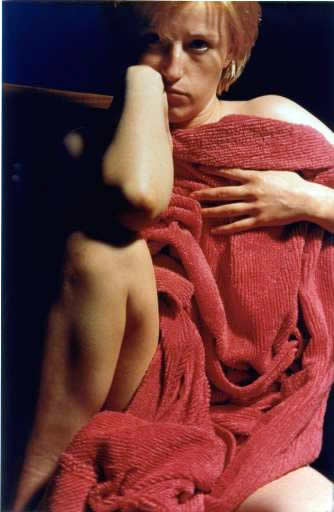
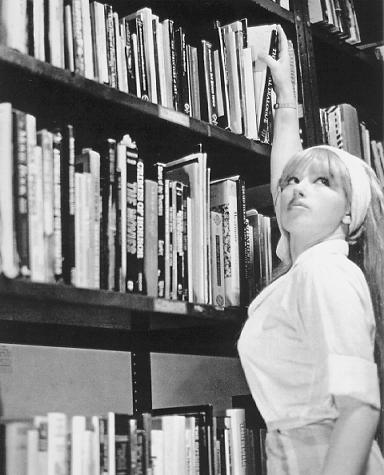 The Unititled Film Stills are all black and white photos in which Sherman places herself as an unnamed actress in shots reminiscent of foreign films, Hollywood pictures, B-movies, and film noir. Sherman used her own possesions as props, or sometimes borrowed, as in Untitled Film Still #11 in which the doggy pillow belongs to a friend. The shots were also largely taken in her own apartment. The Unititled Film Stills fall into several distinct groups:
The Unititled Film Stills are all black and white photos in which Sherman places herself as an unnamed actress in shots reminiscent of foreign films, Hollywood pictures, B-movies, and film noir. Sherman used her own possesions as props, or sometimes borrowed, as in Untitled Film Still #11 in which the doggy pillow belongs to a friend. The shots were also largely taken in her own apartment. The Unititled Film Stills fall into several distinct groups:
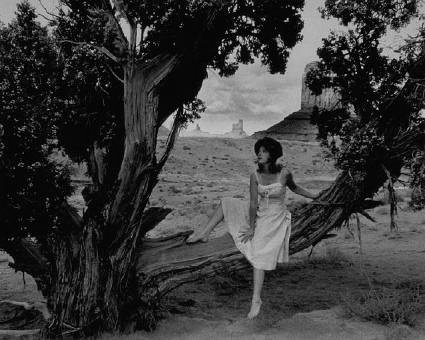 In 1995, Sherman was the recipient of one of the prestigious MacArthur Fellowships, popularly known as the "Genius Awards." This fellowship grants $500,000 over five years, no strings attached, to important scholars in a wide range of fields, to encourage their future creative work.
In 1995, Sherman was the recipient of one of the prestigious MacArthur Fellowships, popularly known as the "Genius Awards." This fellowship grants $500,000 over five years, no strings attached, to important scholars in a wide range of fields, to encourage their future creative work.
 Office Killer
Office Killer
 Dorine lives alone with her handicapped mother. Her daily routine is broken when the company reorganises and is forced to do most of her work online, from her computer at home. One night she has to do some overtime, and accidentally electrocutes one of her bossy colleagues. In a split second her fear switches into power. Where we are used to seeing on-screen murderers who try to conceal their acts, and make them look like accidents, Sherman invert traditional story patterns.
Dorine lives alone with her handicapped mother. Her daily routine is broken when the company reorganises and is forced to do most of her work online, from her computer at home. One night she has to do some overtime, and accidentally electrocutes one of her bossy colleagues. In a split second her fear switches into power. Where we are used to seeing on-screen murderers who try to conceal their acts, and make them look like accidents, Sherman invert traditional story patterns.
 Art by Cindy Sherman:
Art by Cindy Sherman:
 Book Review: Cindy Sherman
Book Review: Cindy Sherman
